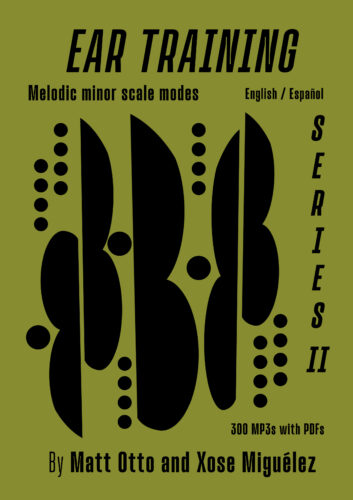Passive Ear Training: A Natural Approach to Hearing and Understanding Modes.
This innovative ear training method, which I call “passive ear training,” mirrors the natural process of language acquisition. By emphasizing repetitive listening and imitation, it cultivates a deep, intuitive understanding of musical sounds.
The course includes over 150 mp3s and a pdf for all 12 keys and of the individual keys.
Buy Melodic Minor Modes Ear Training Series
When using this course:
- Focus on One Key Per Month: Over a 12-month period, immerse yourself in each of the 12 musical keys, allowing for a comprehensive exploration of the major scale modes.
- Listen and Sing: Begin by simply listening and singing along with the provided tracks. Repeat each track until you can confidently perform the entire exercise a cappella, in tune, without the backing track.
- Proof of Learning: Your ability to sing the exercises accurately and in tune serves as concrete evidence of your auditory comprehension and internalization of the material.
- Compounding Effect: As you progress through the series, you’ll experience a cumulative improvement in your ear training skills and modal understanding.
Advanced Stages
Once you’ve completed any one of the exercises deepen your understanding by:
- Intellectual Analysis: Begin to consciously analyze the modes and their relationships to the major scale.
- Numerical Understanding: Develop an awareness of scale degrees and their functions within chords and melodies.
- Instrumental Application: Apply these concepts to your instrument.
- Harmonic Context: Learn to identify specific chord types (e.g., Bb-7b5) and note functions (e.g., b9, #11) within harmonic contexts.
Melodic Minor Scale Modes: A Melodic Approach
This ear-training course serves as an introduction to the modes of the melodic minor scale, using melody as the primary vehicle for understanding. By singing these carefully crafted melodic ideas that outline each mode, you’ll develop a nuanced perception of their unique harmonic and melodic characteristics. By following this method diligently, you’ll not only enhance your ear but also fundamentally transform your understanding of musical modes and their applications.
~Enjoy!

.
Buy Melodic Minor Modes Ear Training Series
Here’s an mp3 of one A melodic minor example below with the pdf. The mp3 is at 50 BPM.
.
.
Buy Melodic Minor Modes Ear Training Series
This ear training method is what I like to call “passive ear training”. Much like the way we learned to speak, the method incorporates listening and copying over and over. What I recommend is focusing on just one key per month over 12 months. This will give you a deep and strong understanding of each of the modes of the major scale in every key. Listening and singing along will be all that is necessary at first. Sing one track over and over until, after stopping the track, you can sing the whole exercise well and in tune accapella. This singing in tune will be proof that you have truly learned to hear the material. If you move through the series this well, it will have a compounding effect and fundamentally change your ear and understanding of modes. After going through all 12 keys begin intellectualizing and thinking about the modes and the numbers or relationship to the major scale. This may include playing the material on your instrument but not necessarily. Just understand each note of the scale or melody in relationship to the chord and root it is found within. Thinking or knowing, “this is the b9, this is the #11, this is a Bb-7b5 chord”, etc…This ear-training course is meant to be primarily a strong introduction to the modes of the melodic minor scale using melody as the entry point. By singing melodic ideas that imply each mode in a clear way you will begin to hear the detail of each mode and its harmonic and melodic significance.
Matt Otto/Xose Miguelez
Spanish:
Spanish: <Modos de la Escala Menor melódica. Cómo utilizar este material. Es relativamente fácil mejorar el oído a través de la escucha, transcripción y el canto. Simplemente cantar junto con estos mp3 es el método principal a través del cual desarrollarás tu oído usando estos ejercicios de entrenamiento auditivo. Al igual que aprender a cantar “Cumpleaños feliz” o cualquier otra canción infantil, simplemente cantar junto con la música desarrollará el oído de manera profunda y natural con el tiempo. Si te pidiera que tocaras “Cumpleaños feliz” en cualquier tonalidad en tu instrumento principal, probablemente empezarías y usarías tu oído para encontrar las notas correctas, corrigiendo cualquier error si surgiera. Esto se debe a que escuchas la melodía con suficiente claridad como para usar su oído como la solución más fácil al desafío. A medida que aumenta la dificultad de la música, tendemos a encontrar otras formas de recordar las notas correctas en lugar de usar nuestro oído o imagen auditiva. Esto se debe únicamente a que no escuchamos esas melodías más complejas y sonidos armónicos tan bien como escuchamos “Cumpleaños feliz”, por lo que confiamos en el pensamiento, las matemáticas, la memoria muscular u otros métodos para producir lo que debería ser totalmente escuchado con la facilidad y claridad de una simple canción infantil. La repetición es clave, y la repetición enfocada utilizando auriculares o altavoces y la coincidencia precisa de tono con tu voz cantada creará un gran impacto y mejorará tu comprensión de la escala menor melódica y sus modos. Tocar estas ideas en tu instrumento probablemente no desarrollará el oído de una forma significativa. Esto se debe a que a menudo desconectamos nuestros oídos cuando tocamos nuestros instrumentos; escuchamos y observamos lo que estamos tocando, pero no “escuchamos” y nos comprometemos profundamente con el sonido. Cuando cantamos y tratamos con intensidad en coincidir con el tono, debemos escuchar profundamente, y nuestro cerebro se desarrolla de manera bastante diferente como resultado. Esta es una de las razones por las cuales el entrenamiento auditivo siempre se debe enseñar solo con la voz y la mente al principio. Puedes utilizar un afinador y ver qué tan bien estás cantando las notas una vez que hayas interiorizado la melodía a través de la repetición. También puedes intentar grabar tu voz cantada y ver si puedes transcribir las notas de la grabación o si un amigo puede transcribir las notas que cantas. Esto te dará una retroalimentación concreta sobre dónde te encuentras en el proceso de desarrollar tu oído y afinación. Creemos que alrededor de 3000 a 5000 repeticiones pueden ser aproximadamente el número correcto para crear una comprensión sólida de estos modos y melodías. En este punto, la repetición cambiará positiva e inequívocamente tus oídos y, a través de una mejor audición y comprensión, mejorará tu interpretación y habilidades musicales fundamentales. Puede parecer que son muchas repeticiones, pero se supone que los seres humanos procesan alrededor de 70,000 pensamientos al día, así que si decides aprovechar un poco de este poder de procesamiento y dedicarlo a dominar estas melodías y modos de la escala menor melódica bastante simples, verás una mejora notable y relativamente rápida, ciertamente en menos de un año. Recomendamos cantarlos una vez al día en una tonalidad cómoda para tu voz hasta que los escuches lo suficientemente bien como para cantarlos a capella. Después de eso, puedes comenzar a utilizar tu instrumento para dominar las 12 tonalidades, los 7 modos y los nombres de acordes correspondientes, la relación escala-acorde y la llamada “teoría musical”. Utilizar el oído primero hará que este proceso posterior sea mucho más fácil y abrirá el mundo de los modos tanto a tu intuición como a tu intelecto.
~ ¡Disfruta! Matt Otto / Xose Miguélez, Junio 2024
